TUESDAY: 2 August 2022. Morning paper. Time Allowed: 3 hours.
The paper is made up of fifty (50) multiple choice questions. Answer ALL questions by indicating the letter (A, B, C or D) that represents the correct answer. Each question is allocated two (2) marks.
1. A unit matrix is a _____________________________.
A. square matrix whose elements have value 0 except for those on the main diagonal which have value 1
B. matrix have one column
C. square matrix whose elements have value of 0 except for those in the secondary diagonal which have value 1
D. matrix whose elements are all equal to one (2 marks)
2. The following matrix, gives the price of comparable articles by size and type in Sh.:

3. Which of the following statements is NOT true about matrix?
A. Matrix can consist of any number of complete row and column
B. The value at the intersection of a row and column is referred to as a call
C. A square matrix is one that has the same element in either row or column
D. The value of a matrix are normally enclosed within a bracket (2 marks)
4. The inverse of a matrix is written as____________________________.
A. A–1
B. A1
C. Both A and B are correct
D. None of the above (2 marks)
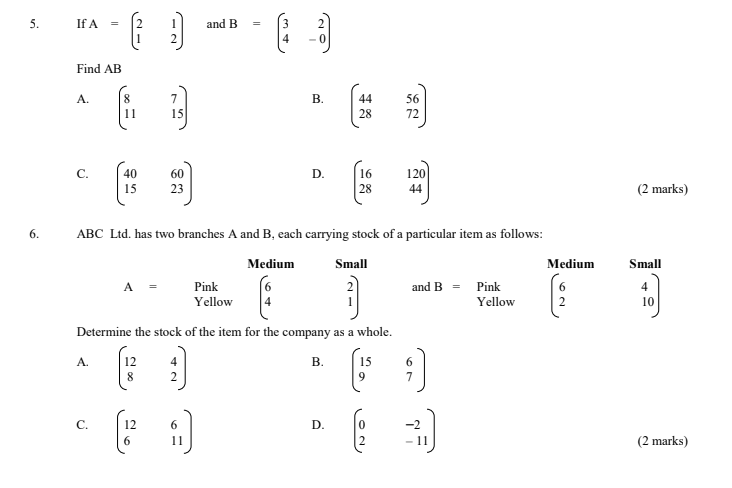
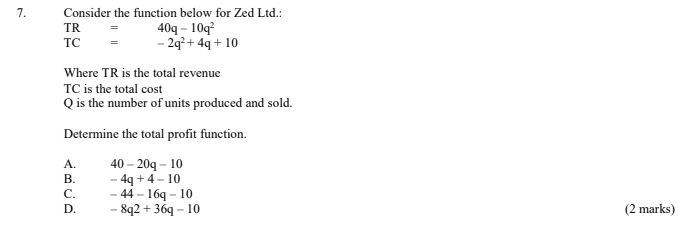
8. A wholesaler sold 15 cartons of washing detergents and 10 crates of soda for Sh.15,500. He later sold 20 cartons of washing detergents and 5 crates of soda for Sh.14,000.
Determine the price of a carton of washing detergent and a crate of soda.
A. Sh.1,000 and Sh.1,600
B. Sh.250 and Sh.400
C. Sh.500 and Sh.800
D. Sh.100 and Sh.160 (2 marks)
9. Gladys Osebe spent half of her salary on rent and 1⁄3 of the remainder on food. If she saved Sh.6,000 how much was her salary.
A. Sh.3,600
B. Sh.18,000
C. Sh.12,000
D. Sh.1,500 (2 marks)
10. Evaluate the following integral
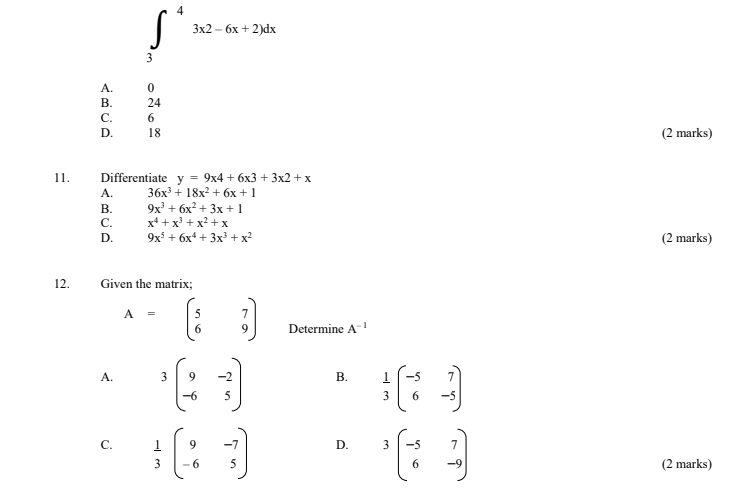

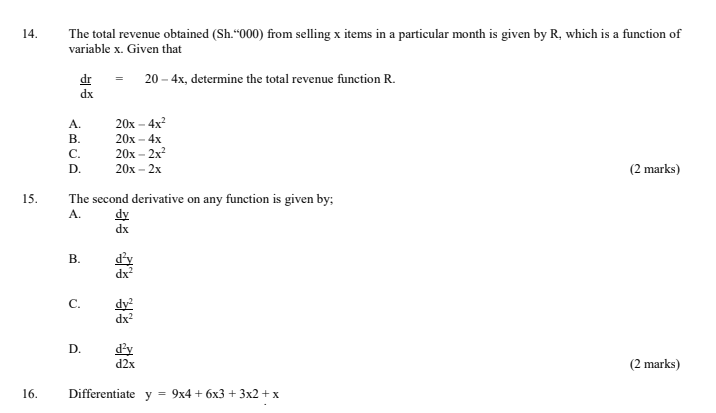
A. Cannot happen at the same time
B. Cannot affect one another
C. Cannot be protected
D. Their respective event sets overlap (2 marks)
17. A manufacturing company is independently working on two separate jobs. The probability that either job will be finished on time is 0.3. What is the probability that both jobs will be finished on time?
A. 0.49
B. 0.09
C. 0.42
D. 0.9 (2 marks)
18. Empirical probability is_______________________________.
A. Probability that is calculated without an experiment being performed
B. Calculated based on the result of repeated performance of an experiment
C. Probability based on prior logical thinking
D. All of the above (2 marks)
19. Given that for event A and B P(A) = 0.6, P(B) = 0.4
Calculate P(A/B)
A. 0.625
B. 0.75
C. 0.25
D. 0.375 (2 marks)
20. The probability of an event must lie between ________________________.
A. 0 to 1
B. – 1 to 1
C. All of the above
D. None of the above (2 marks)
21. The general multiplication role for dependent events A and B is given as______________________________.
A. P(A and B) = P(A) x P(B)
B. P(A and B) = P(A) x P(B/A)
C. P(A and = P(A) x P(A/B)
D. All of the above. (2 marks)
22. The conditional probability that event A occurs given that event B has occurred is given by ________________.

23. The following are sources of primary data EXCEPT:
A. Census
B. Observation
C. Interview
D. Journals (2 marks)
24. Which one of the following is not a source of secondary data?
A. Abstract of statistics
B. Financial statistics
C. Economic trends
D. Direct observation (2 marks)
25. For the following data set, determine the value of x given that the arithmetic mean for the data is 15.5:10, x, 15 and 25
A. 14
B. 15
C. 12
D. 16 (2 marks)
26. Solve for x in the following equation:

28. In which of the following sampling methods is personal bias likely to be introduced.
A. Simple random sampling
B. Quota sampling
C. Purposive sampling
D. Systematic sampling (2 marks)
29. Strategic sampling method is preferred where _________________________.
A. Population is heterogeneous
B. Population is homogenous
C. Large samples are required
D. None of the above (2 marks)
30. Which one of the following sampling methods is a non-probabilistic sampling technique?
A. Simple random sampling
B. Systematic sampling technique
C. Convenience sampling
D. Stratified sampling method (2 marks)
31. ______________________ method of sampling gives each item in the population an equal chance of being selected.
A. Quota sampling method
B. Snowball sampling method
C. Judgemental sampling method
D. Simple random sampling method (2 marks)

33. A bag contains 4 white balls and 3 blue balls. Two balls are picked at random one after another with replacement.
What is the probability that both balls are blue?
A. 16/49
B. 1/7
C. 9/49
D. 6/7 (2 marks)
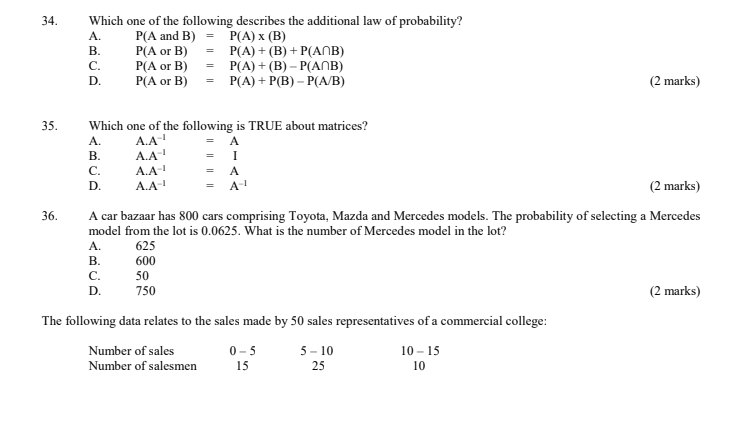
Use the data to answer questions 37 – 39.
37. Calculate the mean number of sales.
A. 16.67
B. 7.5
C. 11.25
D. 7 (2 marks)
38. Calculate the median number of sales.
A. 7
B. 7.5
C. 5
D. 10 (2 marks)
39. Calculate the modal number of sales.
A. 10
B. 7
C. 25
D. 7.5 (2 marks
40. In probability theory what is P(EC ) IF P(E) is 0.02.
A. 1
B. 0.80
C. 0.78
D. 0.98 (2 marks)
41. Two unbiased coins are tossed at the same time, what is the probability of getting two heads?
A. 1⁄4
B. 2/4
C. 1
D. 3⁄4 (2 marks)
42. Which one of the following is not a disadvantage of the arithmetic mean?
A. It is highly affected by extreme values
B. It does not work well with qualitative data
C. It is rigidly not defined
D. Difficult to compute for grouped data with open ended classes (2 marks)
Use the data below to answer Questions 43 – 46.
4, 5 and 12
43. What is the range for the data?
A. 1
B. 8
C. 7
D. – 7 (2 marks)
44. What is the variance for the data?
A. 64
B. 185
C. 12.67
D. 441 (2 marks)
45. What is the standard deviation for the data?
A. 3.55
B. 8
C. 13.60
D. 21 (2 marks)
46. What is the coefficient of variation for the data?
A. 4.77%
B. 12.5%
C. 28.01%
D. 50.84% (2 marks)
47. Use the following data to answer question 47 – 50.
x 2 4 6 8
f 14 20 18 10
A. 2
B. 4
C. 6
D. 8 (2 marks)
48. The arithmetic mean for the data set is______________________.
A. 5
B. 4
C. 4.77
D. 6 (2 marks)
49. The median for the data set is___________________________.
A. 4
B. 5
C. 6
D. 8 (2 marks)
50. To calculate the ________________, all the items of a series have to be arranged in size and order.
A. Arithmetic mean
B. Mode
C. Median
D. Range (2 marks)